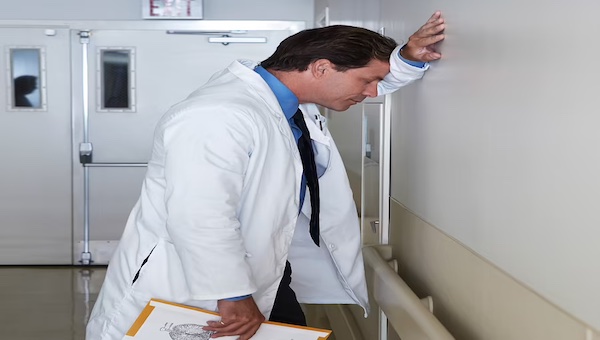
YOU HAVE LIKELY BEEN THE VICTIM OF DIAGNOSTIC MISTAKES
BY: JOE GRAEDONSITE: PEOPLES PHARMACY
TRENDING
Activism
AI
Belief
Big Pharma
Conspiracy
Cult
Culture
Economy
Education
Entertainment
Environment
Faith
Global
Government
Health
Hi Tech
Leadership
Politics
Prophecy
Science
Security
Social Climate
Universe
War
Diagnostic mistakes are common. They can lead to disability, death or unnecessary treatment. A new study shows they are rampant in the ED.
Americans are generally unforgiving when it comes to mistakes. If a bank teller shortchanges you on a check, you would squawk, right? If the expensive smart phone you purchased as a Christmas gift does not work, you would want a replacement or your money back. Why do we accept so many diagnostic mistakes from our health professionals without a word of complaint, especially if such mistakes lead to harm or death?
How Many Diagnostic Mistakes Are Made in ERs?Research released by the Agency for Healthcare Research and Quality (Dec. 15, 2022) should shake the pillars of modern medicine.
The stats are nothing short of shocking :“We estimate that among 130 million emergency department (ED) visits per year in the United States that 7.4 million (5.7%) patients are misdiagnosed, 2.6 million (2.0%) suffer an adverse event as a result, and about 370,000 (0.3%) suffer serious harms from diagnostic error. Put in terms of an average ED with 25,000 visits annually and average diagnostic performance, each year this would be over 1,400 diagnostic errors, 500 diagnostic adverse events, and 75 serious harms, including 50 deaths per ED.”
Perhaps your eyes glaze over with so many numbers. But please reflect for a moment that there are 7.4 million patients who are misdiagnosed every year in emergency rooms in the U.S. If someone is misdiagnosed, she is likely to get the wrong treatment.
The new report suggests that these misdiagnoses lead to:
“… 371,000 (PR 142,000 to 909,000) serious misdiagnosis-related harms, including more than 100,000 permanent, high-severity disabilities and 250,000 deaths.”
Disability and Death:
You just read that 350,000 people experience disability and/or death each year as a result of a misdiagnosis in an emergency room. And yet we predict that this statistic will disappear without a trace in a few short weeks.
Hospitals, emergency departments, medical schools and insurance companies will ignore these startling statistics. Nothing will change.
The Other Side of the Coin:
A study in JAMA Internal Medicine (April 5, 2021) reported that health practitioners dramatically overdiagnose diseases. That can lead to over treatment. And that can lead to side effects or other complications.
Pilots Gone Astray:
Here’s an example of an unforgiving public when professionals make mistakes. On October 21, 2009, Northwest Airlines Flight 188 left San Diego for Minneapolis. For reasons that still remain somewhat mysterious the pilots overflew the airport by 150 miles. They landed in Minneapolis more than an hour late.
No one was injured and no one died because of this error. The pilots were humiliated in the media. The FAA revoked their pilot certificates and the National Transportation Safety Board instituted significant changes in procedures as a result of this screwup.
When Health Professionals Make Diagnostic Mistakes:
If physicians, nurse practitioners or physician assistants make errors, they can easily go undetected. Health professionals rarely get called out for diagnostic mistakes. Patients may not even realize something has gone wrong until it’s too late.
Researchers evaluating primary care visits estimate that about 5% of diagnoses in that setting are in error, affecting approximately 12 million adults each year ( BMJ Quality and Safety , Sep. 2014 ). Please note that theses are “normal” visits to health care professionals, not trips to the ER! Yet the error rate is quite similar.
The researchers conclude:
“Based upon previous work, we estimate that about half of these errors could potentially be harmful.”
If you think 12 million is a large number, consider that this does not include diagnostic mistakes made in hospitals, specialty clinics or nursing homes. If people were actually counting errors, it is likely the number would be far greater.
Do Doctors Mess Up Diagnosis?
How good are physicians, nurse practitioners and physician assistants when it comes to diagnosis? The study in JAMA Internal Medicine (April 5, 2021) suggests that many health care providers drastically overestimate the likelihood of a specific disease condition. The investigators surveyed 553 health professionals. They tested them on four different hypothetical scenarios: patients presenting with possible symptoms of heart disease , breast cancer , pneumonia and urinary tract infections .
For each scenario, the researchers had calculated probabilities based on the scientific literature. The subjects were asked about the likelihood of these conditions before seeing test results and again after they were provided.
In both situations, the:
“practitioners consistently overestimated both pretest and posttest probabilities, often dramatically.”
The authors conclude:
“Widespread overestimates of the probability of disease likely contribute to overdiagnosis and overuse.”
How far off were these health practitioners? Way off! Remember, even after getting test results from chest X-rays, mammograms, exercise stress tests and urine cultures, mistakes were made.
The authors report:
“In this survey study, in scenarios commonly encountered in primary care practice, practitioners overestimated the probability of disease by 2 to 10 times compared with the scientific evidence, both before and after testing.”
A ten fold error is huge.
Malpractice Claims and Diagnostic Mistakes:
Depending upon which study you read, you get either a depressing view or a horrifying view of health care harm. Research on settled malpractice claims concluded that 80,000 to 160,000 people suffer serious disability or death due to misdiagnosis each year ( Diagnosis , Sept. 2019 ). About three-fourths of these grave mistakes involve one of the “big three:” cardiovascular conditions, infections or cancer.
These authors note in their discussion that no one really knows how many people are being harmed or killed by serious diagnostic mistakes in primary care settings.
Citing the BMJ Quality and Safety study, they state that it:
“…would translate to at least 4 million seriously harmed, including at least 1.7 million who died from diagnostic error.”
We grant you that that is the theoretical upper limit. The range for “serious misdiagnosis-related harms” is between 80,000 and 4 million. The reason the numbers are so varied is that no one is actually counting. The CDC does not include diagnostic mistakes on its list of leading causes of death. Death certificates rarely, if ever, list cause of death as “diagnostic error” or “medical mistake.”
Misleading Death Certificates:
What you are likely to see on a death certificate is “cardiac arrest,” “respiratory arrest” due to COVID-19 or “intracerebral hemorrhage” (stroke). When Helen Graedon (my mother) died after a series of medical errors, the death certificate stated that her death was caused by “cardiac arrest” due to “hypotension” (low blood pressure) as a consequence of “retroperitoneal hemorrhage” internal bleeding. Nowhere was it mentioned that the medications she was mistakenly given in the hospital triggered something called serotonin syndrome that likely contributed to the internal bleeding.
If anyone were counting, diagnostic mistakes would be a leading cause of death in America. But unlike heart disease and cancer, there is no Institute of Diagnostic Mistakes . Politicians allocate billions of taxpayer funds to the National Cancer Institute, the National Heart, Lung, and Blood Institute, the National Institute on Alcohol Abuse and Alcoholism and the National Institute of Allergy and Infectious Diseases. But barely a drop in the bucket goes to preventing healthcare harm due to faulty diagnosis.
Why Proper Diagnosis Matters!
When you see doctors for troublesome problems, you probably expect them to uncover the reasons for your symptoms. Accuracy matters, because undergoing treatment for the wrong condition won’t help and may do you harm.
Treatment delay could be deadly. In addition, you could be taking medicine with potentially serious side effects that won’t help your condition at all.
Overlooking Drug-Induced Side Effects:
Doctors may also have trouble diagnosing reactions to medications they have prescribed. We have heard from hundreds of people describing a wracking cough that took them into the clinic time after time.
Some took cough medicine or antibiotics that did nothing, while others underwent multiple tests for infection, allergy or asthma, without result. Eventually, for these readers, the source of the problem was identified as an ACE inhibitor blood pressure medicine, usually lisinopril.
While the ACE-inhibitor cough is extremely uncomfortable, it is rarely life threatening. A different reaction to this drug, angioedema , can block airways. Intestinal angioedema can also cause serious harm, but it may be difficult to diagnose.
One reader related this experience:
“I came across your website while literally writhing in agony after my first dose of lisinopril. My stomach felt like I had eaten a bag of glass. After hours of agony and consulting Dr. Google, I knew what it was and went to the ER.
“None of the doctors had even heard of it before. I kept yelling to my husband, ‘Tell them about intestinal angioedema!’ All three doctors were flabbergasted that just one dose could cause this. I was in the hospital for four days. Moral of the story–be your own advocate!”
Millions of people take lisinopril without problems. When people do develop adverse reactions, though, health care providers must be alert to that possibility.
Protecting Yourself from Diagnostic Mistakes:
What can patients do to protect themselves from misdiagnosis? Dr. David Newman-Toker is Director of the Armstrong Institute Center for Diagnostic Excellence at Johns Hopkins University School of Medicine. He suggests that patients prepare a summary of their symptoms and history before seeing a clinician. After getting an initial diagnosis, ask:
“What is the worst thing this could be?”
Follow up with:
“Why is it not that?”
To learn more and listen to Dr. Newman-Toker describe diagnostic mistakes, you may want to listen to Show 1239: How Can We Prevent Diagnostic Disasters?
Click 3 Dots Below to View Complete Sidebar



